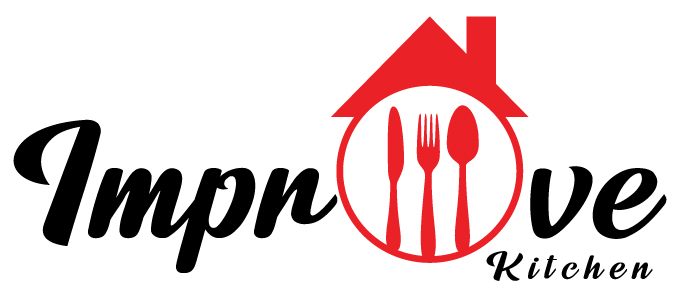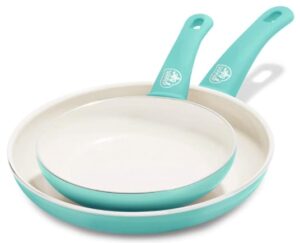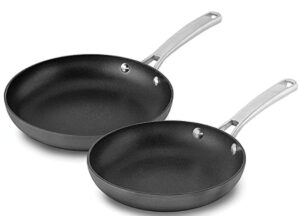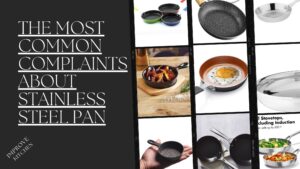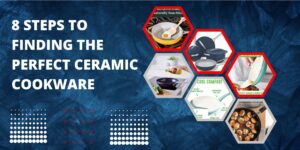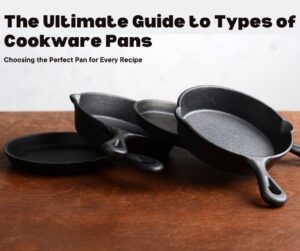Nonstick pans are a cheif’s best friend. A well-seasoned frying pan is like an extension of the cook, always at hand for any need that may arise. It’s never more than arm’s length away and ready to jump in whenever needed to do some quick deglazing or sautéing. But cooks often find themselves frustrated with their nonstick pans because they don’t work as advertised – food sticks! That can be frustrating enough when you’re cooking for one person, but imagine trying to feed your family dinner using nothing but sticky, uncooperative pots and pans? Nah. Not going to happen anytime soon. The solution? Invest in ceramic vs Teflon nonstick pans.
The real trouble with finding a good nonstick pan is that everybody has their favourite. All of them are stubbornly opinionated about the best way to get results, without any facts about how ceramic materials can provide better cooking performance. Until recently, it had been pretty much-accepted wisdom that Teflon was the superior choice for high-quality cookware because of its chemical inertness, resistance to scratches and stains, durability etc. But some recent studies have shown that there might be long term health issues associated with using PTFE based coatings on pans – so-called “Teflon flu”, which means exposure to toxic fumes when overheating certain kinds of Teflon pans.
Ceramic vs Teflon, which is better? It may be hard to decide for many people, so that’s why in this blog post, we’ll go over what makes Teflon a better option than Ceramic for cookware items such as frying pans- so keep reading if you’re curious!
Ceramic
Ceramic is an excellent material to use when looking for nonstick pans, but not all ceramics are created equally; some ceramic pans feature a coating made from zirconium oxide, a highly durable and heat-resistant compound. Due to their unique composition and properties, ceramics of this variety will not only offer the best nonstick surface for your food but will also be scratch resistant and more environmentally friendly than other types of pans.
For example, green pans use a ceramic material crafted from the elements of boron and oxygen. The naturally non-toxic properties of these substances mean they can be used to replace toxic items such as nonstick coatings in cooking utensils, which makes them very safe for both home and commercial use.
There are three different types of ceramic used in cookware: earthenware, porcelain and stoneware.
Earthenware
Earthenware is the cheapest ceramic style and is excellent for decorative purposes. This material is made from clay that has been fired at very high temperatures. Since the material is porous, you will need to be extra careful to absorb stains and odours easily. You can’t use this material for cookware that needs to withstand very high levels of heat.
Porcelain
Porcelain is made by mixing ground-up materials with fine white clay to create a smooth, translucent paste. It’s then fired at very high temperatures (2200 °C – 2600 °C) to produce durable, hygienic and beautiful ceramic cookware. These are a popular choice for those who want their cooking utensils to look good on kitchen countertops.
Stoneware
Stoneware is made from heat-resistant porcelain and fired at even higher temperatures than ceramic. Because of this, it can withstand very high temperatures and is a popular choice for use in the most demanding commercial kitchens.
Pros:
- They are more affordable than Teflon pans.
- They are easy to clean and maintain – you can wash them in the dishwasher!
- Food doesn’t stick to them, so they make cooking a less tedious task.
Cons:
- They aren’t suitable for glass stovetops. Ceramic cookware will scratch your glass stovetop, which means you need to get rid of your ceramic cookware if you want to use a glass stovetop.
- They are not appropriate for eggs. Don’t try cooking eggs in ceramic pans! It can be harmful to humans.
- Some people find that food cooks unevenly on ceramic pans due to thermal conductivity issues.
Teflon
Teflon is a brand name for a type of nonstick coating that is applied to cookware. The layer is made from a synthetic material called polytetrafluoroethylene (PTFE). Roy Plunkett invented Teflon in 1938, and the first Teflon-coated frying pan was sold in 1954.
Teflon is popular because it is very durable and resistant to scratches and stains. The coating does not react with food, so food doesn’t stick to it. This makes cooking a less tedious task.
However, there are some health concerns associated with using PTFE-based coatings on pans. “Teflon flu” refers to exposure to PTFE fumes, which cause flu-like symptoms in some people. It’s not entirely clear why this occurs, but it is thought to be caused by the release of minute particles of PTFE into the air when pans are heated up to very high temperatures (over 500° C).
Because Teflon coatings are difficult to clean with conventional dishwashing detergents, they can retain grease and bacteria buildup. This can lead to problems such as food poisoning or stains on the cookware surface.
The FDA now permits low levels of PFOA (perfluorooctanoic acid) to be used in nonstick coatings; however, there is some concern that long-term exposure may increase the risk of specific health problems.
Teflon coatings are also flammable, so you should avoid using Teflon cookware at high temperatures.
Pros:
- They are very durable and resistant to scratches and stains.
- The coating does not react with food, so food doesn’t stick to it. This makes cooking a less tedious task.
- They are popular because they are very affordable.
Cons:
- They are less affordable than ceramic pans.
- The nonstick coating is flammable. It would be best if you did not use Teflon cookware at high temperatures.
- They are challenging to clean, which means they can retain grease and bacteria buildup over time.
Ceramic vs Teflon Pans – Major Differences Between Them
The primary difference between ceramic pans and Teflon is that while ceramic pan doesn’t stick to food, they can scratch or chip on the top of your stove. Ceramic also overheats easier than Teflon, so it’s not recommended for stir-frying.
Teflon pans are more expensive than ceramic, but you get what you pay for! Unlike ceramics which require special care with cleaning, high heat cooking, acidic foods, eggs etc., Teflon will not react to anything in your pan. This means less time cleaning up messy pots and pans! The coating is durable, prohibiting chemicals from getting into your food–no flavour compounds can come off on your fingers or clothes when handling as steel wool would do on dishes.
Teflon can be washed in the dishwasher; unlike most ceramics, it has the most convenient easy-clean properties.
With ceramic pans, food is more likely to stick to the pan than with Teflon, which means you will need a lot of oil or butter for cooking and parboiling food longer to make sure all the water boils out before you finish with your recipe; ceramic pans require nothing but boiling water for cooking rice.
Ceramic nonstick cookware is typically challenging to care for, like cast iron; no commercial cleaners can easily tackle burnt-on messes. They also overheat easier than their Teflon counterparts, thus making them not safe for stir-frying; even at medium heat, they can release fumes which can cause severe flu-like symptoms in some people.
Unlike ceramic, Teflon is a layer of PTFE molecules sealed between two sheets of stainless steel. The coating doesn’t react with food so that that food won’t stick to it. With Teflon, all you need is a drop of oil or butter, and your pan will remain virtually nonstick for most cooking tasks!
Frequently Asked Questions:
Q-1) Which nonstick material has replaced Teflon?
Ceramic cookware has replaced Teflon as it is generally considered to be safe. However, It is less resistant to scratching and may lose its nonstick properties if not used as directed.
Q-2) Why is Ceramic cookware less expensive than Teflon?
A- Ceramic cookware is cheaper because it requires special care in cleaning, high heat cooking, acidic foods and eggs. Teflon requires nothing but boiling water for cooking rice.
Q-3) Is Teflon cancerous?
A- PFOA (perfluorooctanoic acid) is known to cause cancer and birth defects in lab animals; however, its use in nonstick coatings was phased out in 2015 by the US Food and Drug Administration. As a result, most companies have substituted PTFE for PFOA. Some experts believe that PTFE is far safer than PFOA because it breaks down into inert compounds at high temperatures.
Conclusion
Ceramic nonstick pans are better suited for cooking dishes that require a lot of stirring or adding water to your pan, while Teflon is best for food which won’t stick to the pan, and you have time to let it do so.
Overall, Ceramic has more pros than cons but is not enough to beat Teflon’s beautiful features. Although ceramic may seem more earth-friendly due to its natural material, it’s not as long-lasting as Teflon and requires a lot of care to function properly.
You must choose the best nonstick cookware for your needs after considering all the factors discussed above. It may be tempting to purchase a low-cost ceramic nonstick frying pan, but I assure you that it is not worth the money you spend on it.
